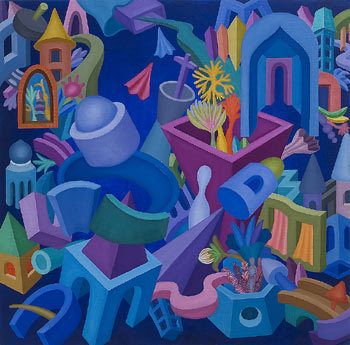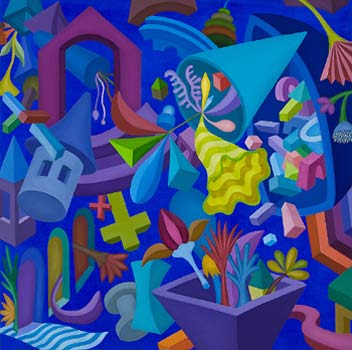|
A Countless World
Jhe You-Sung's Painting
Park Youngtaik
art critic, professor of Kyonggi University
The paintings of Jhe You-Sung can resemble screens filled with tightly stacked-up little toys. Her paintings can also look like a mess children usually leave behind. The objects that fill the screen remind you of claustrophobia and hint of a stubborn desire to collect and possess.
 |
| A Journey into Another World, 2009, oil on canvas, 80x80 |
The traces of play left behind by children’s toys are in many ways a microcosm of the grown-ups’ world. The objects and the worlds, scaled down to the physical capacity of children, are then a representation of the desire of small children to overcome the grown-ups’ physique. To the children, the little dolls and toys they play with also act as an alternate personality, that is, an alter-ego.
Because children are creatures with all the inconsistencies and extremes of life, the world they construct leaves intact all the contradictory emotions apparent in their world and play. The painter’s works, which once spoke to my and our worlds, now confront us with the time and space that are strangers to us. They bring back moments of joy we still recall from playing with our dolls and toys.
The dolls and toys are substitutes for us and our things, and children simulate the world of the grown-ups. They make believe.
|

|
| A Journey into Another World, 2009, oil on canvas, 183x227 |
They build an imaginary empire only they know how, expand it, and express a defensive, closed world views. Through it, they hold on to their sense of security. Rather than becoming a part of the existing order, they sometimes dream of a new world order and a territory different from the one the grown-ups created. It is an unreal world and territory built within the realm of reality.
The artist brings forth the plays of our childhood and reincarnates them through her paintings on flat screens. If one thinks about it, the art of painting embodies the desire to punch a hole through the reality and imagine the unreal world. In the process, the world of paintings, the objects and images that the painter allows, controls, and rules, conflicts with the daily hardship that dictates and reigns over the painter. You-Sung’s tenacious and uncompromising paintings are like a cushion that resolves the clashes and conflicts of our reality and terminates them within the relative safety of paintings. It’s the same desire that draws children to paint.
 |
| A Journey into Another World, 2009, oil on canvas, 80x80 |
The canvas is both a real and a virtual space. It illustrates not what is real, but certain situation and state of mind possible only in our imagination, in our paintings. So anything can be imagined and carried out in a painting. There is no such thing as a boundary or a taboo. In that canvas space, the artist employs small building blocks, multiplies them, and works toward a scene or a story.
The little objects and shapes, spread over a relatively cavernous space, are the minimal units of building blocks that must pair up and fit with the rest, much like pieces of a Lego set or the components of a toy. They resemble the necessities of life or the shape of instruments; at times, they are the miniature of reality itself. By matching up with other pieces and parts, they can produce a circumstance. What is seen on the painting is not a perfect pair, but the scattered individual pieces just moments before.
They float in the vacuum of the sparking symbiosis between space and objects. With their distinct and obvious forms, the pieces and parts create abstract scenes. As the sizes shrink and the physical relations fade, the objects evoke rather delicate sensations. They are arranged and juxtaposed only according to the choice and priority of the painter herself. At the moment of the first stroke, while lost in the journey and time, the artist finally gets to taste the sweetness of freedom. The art of merrymaking paintings takes us to the encounter when children were running around with their toys and imagining all that is possible. So the work itself metamorphoses into a festival.
|

|
| A Journey into Another World, 2009, oil on canvas, 80x80 |
Inside the festival-like painting, dreams of the world only she pursues unfold. As the painter paints her way through and moves deep into her space, she decides on the size and relationship of her objects on her own and forges ahead. It is like a palette of words of similarity, putting an assortment of words together to form sentences and creating texts that only she herself can decipher. Still, the painter repeatedly draws symbols that resemble houses and buildings, perhaps a space she would call a home or a sanctuary that protects her from the elements and discreetly comforts her. Inside the house, we see door and windows, her secret passageways, perhaps.
Her primary interests are the nooks and crannies that demolish the boundaries between boundaries. The windows and the doors also serve as a thoroughfare through which minds travel back and forth. It is the point of contact where inside and outside, interior and exterior become one. It is where we find anxiety and curiosity about the creature that occupy the space inside the doors and windows. The painter is curious about it. It is a scene absent of any human form, but nevertheless one teeming with embodied objects and marbles and seeds and life-possessing eggs from all directions. It’s almost like a heart full of life about to burst. Seen from this angle, the painting closely resembles the painter’s psychological blueprint.
As the painter fills the screen through countless hours of labor, she dissolves the weight of life and the mental burden with a great sense of humor. The shapes and forms on the screen, with their thicknesses and shadows, are uneven and three-dimensional. They resemble pieces of a Lego set and parts of toy collections. The house and the stairway, the table and the chair, the squares and other shapes culminate with colorful, shiny, and slippery plastic texture. They burst into the space and float around. Each of the countless, multiplying objects occupies its own space.
|

|
| A Journey into Another World, 2009, oil on canvas, 183x227 |
That they are countless suggests they defy our visual command and any attempts to tame them. As such, although they represent a world open to our eyes, they yet boldly reveal a world invisible to our eyes. Although unsteady and ambiguous, it is an independent and complete world. So it is a self-sufficient situation. The seemingly no-longer useful, aimlessly floating objects proudly take the center stage in the painter’s work. The countless, over-flowing, and piling objects seem like a subtle metaphor for the reality of the world. That only a few objects can create an endless world with their shifts and arrangements hints of a rendezvous between the desired relationship and dialogue.
Moreover, the sparkling marbles overflow in all directions and allude to sprouting, multiplying living creatures. It is not a world of rigid, angled objects, but one of fluid, organic, and squirming senses. The emphasis on the complex, commingled state also displays the maze-like life of confusion and boisterousness. It is like the work of children’s coloring with carefully drawn figures, shapes and shadows in great variety that can imagine any world in harmony. It is a world created haphazardly, accidentally, as dictated by an instantaneous imagination, not with any plan or purpose.
This could be the world the painter intended. The painter’s imagining of her own fortress or kingdom and being ensconced in it reflects the painter’s yearning for isolation and seclusion but also self-defeat at the same time. It is also a story, a soliloquy, of the life of the painter persevering with persistent and stubborn dedication to her art. Standing with my eyes helpless before the painting, I listen to that soliloquy.
Jhe, You-Sung
www.jheyousung.com
Instructor at the Painting & Print Making Department of Ewha Womans University and Sangmyung University
1994 MFA: San Francisco Art Institute
1991-93 Studied at University of Texas at Austin
1989 MFA: Painting and Print Making, Ewha Womans University, Seoul
1987 BFA: Painting and Print Making, Ewha Womans University, Seoul
One Person Exhibition
2009 Artlink Gallery, Seoul
2006 AKA Seoul Gallery, Seoul
Hangaram Gallery, The Korean Culture & Arts Foundation, Seoul
2004 Hangaram Gallery, The Korean Culture & Arts Foundation, Seoul
2003 Sagan Gallery, Seoul
2002 "Window Show", Hyundai Gallery, Seoul
1998 Moin Gallery, Seoul
1992 New Gallery, Austin
Group Show
2009 A Part of Me, Space Ham, Seoul
Chailim Group Show, Kwanhoon, Seoul
Europe Art Fair, Geneva
Korea Galleries Art Fair, Bexco, Busan
Art Daegu, Exco, Daegu
3Artists Show, Moin Gallery, Seoul
2008 Seoul International Arts Fair, Coex, Seoul
Art Daegu, Daegu Exco, Degu
Chailim Group Show, Kwanhoon Gallery, Seoul
Ewha Fine Arts Exhibition, Insa Art Center, Seoul
2007 Sweet, Artpark, Seoul
Art in Philosophy, SungGoK Museum of Art , Seoul
Chaelim Exhibition, Kwanhoon Gallery, Seoul
Philosophy Tales, Hyundai Department Store Gallery, Seoul
2006 Ewha Fine Arts Exhibition, Sejong Center for The Performing Arts Museum, Seoul
Chaelim Group Show, Kwanhoon Gallery,Seoul
11artists, Aka Seoul Gallery, Seoul
2005 Chaelim Group Show, Kwanhoon Gallery, Seoul
2004 Relation, Encounter, Regeneration, Moon Gallery, Seoul
Chaelim Group Show, Kwanhoon Gallery, Seoul
2003 Chaelim Group Show, Kwanhoon Gallery, Seoul
2002 Ewha Fine Arts Exhibition, Kwanhoon Gallery, Seoul
2000 Intellect & Sensibility for the 21st C, Seoul Arts Center, Seoul
1999 Eidos, Kwanhoon Gallery, Seoul
1998 Ewha Fine Arts Exhibition, The Korean Culture & Arts Foundation, Seoul
1992 Spirit and Form, Performing Arts Center, Austin
1989 Direction of 1989, Yoon Gallery, Seoul
Transition of 1989, Kwanhoon Gallery, Seoul
Eidos, Kyung-In Museum of Fine Arts, Seoul
1988 Transition of 1988, Kwanhoon Gallery, Seoul
Eidos, Kyung-In Museum of Fine Arts, Seoul
Protagonist II, Kyung-In Museum of Fine Arts, Seoul
1987 Protagonist I, Arcosmo Gallery, Seoul
Seoul Rising Painter Show for 1987, C.Y. Gallery, Seoul
The 7th Exhibition of Korean Modern Printing, Batangol Gallery, Seoul
1986 Mokwoo Art Festival, National Museum of Contemporary Art, Seoul |